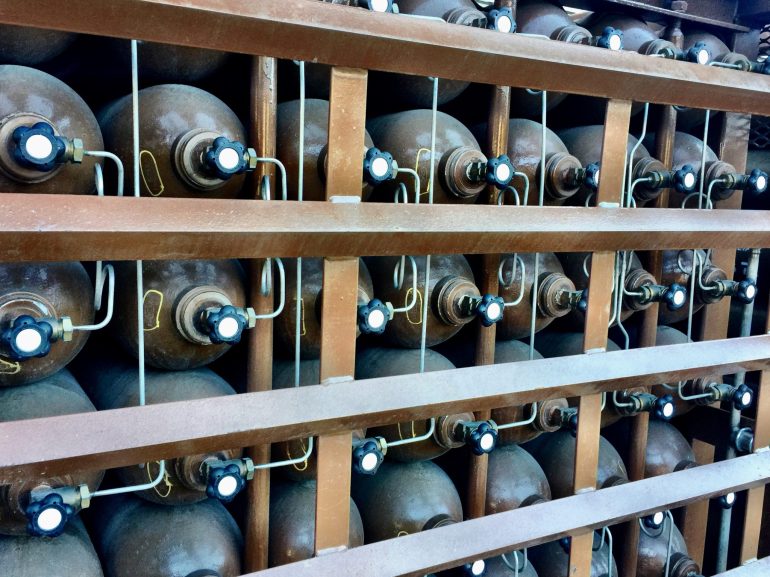Named after the Greek word ‘helios’ meaning sun, helium was first discovered during a solar eclipse in 1868 by – amongst others – Lieutenant John Herschel, the grandson of William Herschel, the man who discovered Uranus in 1781.
It’s produced – and incredibly abundant – in the universe by fusion reactions inside stars, though it’s rare on Earth.
It’s produced deep underground, over the course of thousands of years, as a result of radioactive decay of heavy elements including thorium and uranium. It rises up and gets trapped in pockets of natural gas and is extracted at gas fields predominantly in Kansas, Texas and Oklahoma. There are also smaller deposits found in Qatar, Canada, Algeria and Poland. Here, we’ll tell you how helium gas is made.
Helium - A Short History

Icon of Helium Periodic Table of Elements (Photo: bamlou via Getty Images)
Helium was first observed in 1868 but it wasn’t until 1895 that it was first identified on Earth. It was isolated from a variety of the mineral uraninite quite by chance by Scottish chemist Sir William Ramsay, who was in fact looking for argon. Independently in the same year, Swedish chemists Per Teodor Cleve and Nils Abraham Langlet did the same thing.
Quickly understanding how helium is made and realising it was lighter than air and inert, it replaced the highly volatile hydrogen as the gas of choice for airships in the early 1900s. It wasa also used in World War II to inflate the tyres of bombers, allowing them to carry more fuel.
Today, helium is put to all manner of commercial and industrial uses, including as a coolant for the LHC, the superconducting magnets in MRI scanners and satellite instrumentation. It is also used to inflate car airbags, to manufacture fibre optics and barcode scanners, and mixed with oxygen it is used by deep-sea divers.
Most importantly of course it’s used to inflate party balloons, but how is helium produced? Here’s the lowdown.
How Helium is Made - The Natural Gas

Compressed Helium (Photo: Oliver Strewe via Getty Images)
Similar to the way propane gas is produced, helium starts with natural gas. As the natural gas is extracted from the ground, it contains methane and hydrocarbons as well as much smaller amounts of carbon dioxide, nitrogen, water and helium. For the gas to be used at home, all these extras must be removed in a process known as upgrading.
In order to get the helium to 99.99% purity, the water vapour, carbon dioxide and hydrocarbons are removed from the natural gas. It then goes through a process called fractional distillation, which separates the nitrogen and methane by way of gravity.
By now the methane has liquified so it sinks to the bottom of the chamber while the nitrogen and helium rise to the top. Most of the methane is drawn out, most of the nitrogen condenses into a vapour and what’s left is around 60% helium, known as crude helium.
How Helium is Made - Purification

Oxygen and Helium bottles (Photo: kjerulff via Getty Images)
The answer to the question ‘how is helium manufactured’ is incredibly complex and the next part of the process involves the purification of the crude helium. At this stage, there remain other materials in the crude helium, including the leftover nitrogen and methane. The helium is cooled to -193°C which liquifies the methane and nitrogen and they are drained away. Now, we’re up to about 90% helium.
Oxygen is now added to the mix, which reacts with the last hydrogen molecules to form water and is subsequently drained off. To ensure the remaining unwanted gas particles are removed, the helium – now around 95% pure – is filtered through a machine called a pressure swing adsorption unit, which is home to tens of thousands of particles filled with miniscule pores. All the unwanted gas particles get trapped in these pores (the process is repeated if necessary) and once this is complete, the helium is approximately 99.99% pure.
How Helium is Made - Distribution

Woman inflating helium balloons (Photo: JGI/Jamie Grill via Getty Images)
Helium is shipped either as a gas or as a liquid. The gas is pressurised in steel or aluminium cylinders, but if it’s to be delivered as a liquid, it must go through one further process to ensure it’s perfectly clean. First, the gas is filtered over a bed of activated carbon in a cryogenic adsorber at a temperature of -253°C, which removes any tiny impurities. Finally it’s passed through heat exchangers and expanders and the temperature of the now-liquified helium is down as far as -269°C, just 4.15°C above absolute zero. At this point it can be considered 99.999% pure helium. It’s then pumped into an insulated vacuum shell tanker for distribution to its final destination. So, that’s how helium is made. It takes a while but it’s worth it for the balloons!











